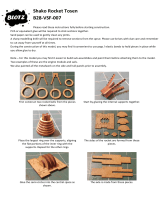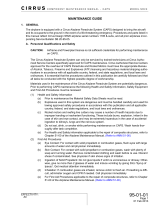
Page 1
Assembled In USAKit #05064
Skill Level 4
Manufactured in the USA by:
Apogee Components Inc.
Colorado Springs, Colorado, USA
www.ApogeeRockets.com
Instruction Sheet A: P/N 31267 *Updated 6/23/2023
The TTV (Timer Test Vehicle) began as an internal project
to allow us to quickly and inexpensively test the new version of
the Simple Timer (version 3) and it quickly became apparent
just what a useful little rocket this is. It’s designed to do exactly
what the name suggests, to allow testing of staging timers.
What that means, however, is that the TTV is an excellent
indirectly staged rocket for low-cost ights with electronics. It
also is capable of ying with electronics beyond those that we
originally designed it for. Despite the small size of the rocket,
the ebay is actually large enough to test a wide variety of ight
computers either for use as an apogee deployment charge,
as a staging controller, or both. This makes the TTV usable
for both single and two stage ights and for both black powder
and composite motors.
This kit represents the third version of our inhouse design
with a majority of the later work focused on making sure that
this kit is as easy to build and use as possible. Given its small
size and the fact that we wanted to allow use of either elec-
tronic or motor ejection, there is a lot of technology packed
into a small space with this model. That could easily make for
a difcult build, awkward use, or both. Neither of those were
what we wanted. Who wants a test program that’s difcult? So
we went to work nding all the pain points and smoothed them
out to make a rocket that takes advantage of modern electron-
ics and high-impulse motors to bring indirectly staged rocketry
into a baseball eld friendly package.
Item # Item Name Qty
09184 Simple Switch with 4" Wires 1
10002 4mm x 3" LC Straw 1
10068 AT-18/2.75” 1
10091 AT-24/3.75” 1
10117 AT-33/7.5” 1
10152 AT-41.6/18" 1
13029 CR-13/18 (BLUE) 1
13031 CR-18/24 (GREEN) 2
13056 1/4" Launch Lug 3" Long 2
13075 Removable Plastic Rivet 2
13121 AC-41.6 1
15418 TTV Ebay and Centering Rings Sheet 1/8" Ply 1
15419 TTV Frame Sheet Cardstock 1
15730 TTV Fin Sheet 3/32"x4" Basswood 1
19469 PNC-41.6 (BT-60) 1
24043 Regular "D" Crimped Engine Hook 1
24044 Crimped "E-size" Engine Hook 1
29090 12" Printed Nylon Parachute 1
29092 18" Printed Nylon Parachute 1
29519 100# Kevlar x 6 feet 1
29526 300# Kevlar x 6 feet 1
31267 TTV Instruction Sheet A 1
31268 TTV Instruction Sheet B 1
31269 TTV Instruction Sheet C 1
31270 TTV Instruction Sheet D 1
39058 TTV Face Card 1
41114 TTV Decal Sheet 1 1
41115 TTV Decal Sheet 2 1
Needed Tools and Materials
Pencil
Hobby Knife with Sharp Blades
Razor Saw
Wood Glue
Thin CyA Adhesive
Medium CyA Adhesive
Masking Tape
Sandpaper (180-220 grit and 320-400 grit)
Optional Tools / Finishing Supplies
Electronics for Staging (such as Simple Timer P/N
09142)
Fin Alignment Guides (P/N 35539 and P/N 35546)
Paper Towels
Spray Paint
Soapy Water
Wood Dowel
Skill Level 4
Slightly Challenging
TTV Parts List
TTV

















